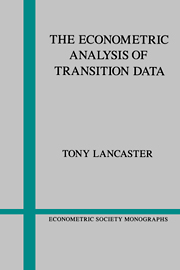Book contents
- Frontmatter
- Part I Model Building
- 1 Some Basic Results
- 2 Covariates and the Hazard Function
- 3 Parametric Families of Duration Distributions
- 4 Mixture Models
- 5 Some Important Processes
- 6 Some Structural Transition Models
- Part II Inference
- Appendix 1 The Gamma Function and Distribution
- Appendix 2 Some Properties of the Laplace Transform
- Bibliography
- Index
2 - Covariates and the Hazard Function
Published online by Cambridge University Press: 05 January 2013
- Frontmatter
- Part I Model Building
- 1 Some Basic Results
- 2 Covariates and the Hazard Function
- 3 Parametric Families of Duration Distributions
- 4 Mixture Models
- 5 Some Important Processes
- 6 Some Structural Transition Models
- Part II Inference
- Appendix 1 The Gamma Function and Distribution
- Appendix 2 Some Properties of the Laplace Transform
- Bibliography
- Index
Summary
Introduction
Economic data are rarely homogeneous; we seldom have observations that can be regarded as repeated drawings from the same probability distribution. We normally must allow for measured, and possibly for unmeasured, systematic differences between people, firms, or whatever is the unit of observation. In this chapter we shall introduce regressors or covariates explicitly into the hazard function and discuss the various types of covariate that econometricians seem likely to want to consider. We shall see that some of the relations of chapter 1 can fail to hold when covariates are present.
We shall suppose in this section that all covariates are fully observed by the econometrician. In chapter 4 and subsequently in many parts of the book we shall deal with models containing unobserved covariates.
Time-Invariant Covariates
The simplest covariates are those which do not change over time. Two examples might be the sex or the race of a person. More generally, the relevant characteristics of an agent at the time of entry to the state under study, that is, his relevant biography to that point in time, constitute a set of duration-invariant regressor variables. Other variables can and do change as the duration of stay changes, but at a sufficiently slow pace relative to typical durations of stay that, for practical purposes, they can be treated as if they were constants. Two examples might be the age of a person, or the state of the business cycle, in the context of studies of unemployment duration.
- Type
- Chapter
- Information
- The Econometric Analysis of Transition Data , pp. 21 - 32Publisher: Cambridge University PressPrint publication year: 1990



